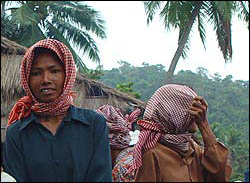Cambodian Clothing
Most Cambodians spruce up coolly aside from when they are going to formal occasions. It is regular to see men and ladies utilizing Krama, a Long, Narrow checked cotton fabric round their neck. The krama is much the same as a bit of dress.
Lightweight, baggy, cotton dress is suggested and since quite a while ago sleeved things ought to be incorporated for insurance from mosquitoes and the sun. Amid the blustery season an umbrella is more advantageous than a downpour coast. A coat may be required in lodgings and eateries utilizing over the top aerating and cooling.
Textiles
There are three vital silk materials in Cambodia. They incorporate the ikat silks (chong kiet in Khmer), or hol, the twill-designed silks and the weft ikat materials. Examples are made by tying regular and manufactured strands on the weft strings and afterward it is colored. It is rehashed for diverse hues until the examples firm and fabric is woven. Generally, five hues are utilized. Red, yellow, green, blue and dark are the most utilized. The Sampot Hol is utilized as a lower piece of clothing and as the sampot chang kben. The Pidan Hol is utilized as a stately hanging utilized for religious purposes.
Alcoholic silk weaving has been an imperative piece of Cambodia's social past. It has been archived that individuals from Takéo Province have woven silk since the Funan time and records, bas-alleviation and Zhou Daguan's report have demonstrated that weaving machines used to weave sampots since antiquated times. Since old times, ladies have adapted profoundly complex routines and mind boggling designs, one of which is the hol technique. It includes passing on examples on silk before weaving. What stays remarkable to Cambodian weavers is the uneven twill system, the reason stays vague why they embraced such an uncommon technique. The antiquated bas-reliefs however gives a complete take a gander at how fabrics were similar to, down to designs and creases. Silk woven pieces are utilized as treasures, in weddings and funerals, and as embellishment in sanctuaries.
Sampot
The sampot is the national article of clothing of Cambodia. The conventional dress is like those well used in the neighboring nations of Laos and Thailand, however varieties do exist between the nations. The sampot goes back to the Funan time when a Cambodian ruler purportedly requested the general population of his kingdom to wear the sampot at the solicitation of Chinese agents.
There are numerous varieties for the sampot, each is washed by class. The normal sampot, referred to additionally as the sarong is commonly worn by men and ladies of lower class. It gauges roughly one and a half meters and both closures are sewn together. It is fixed to securely secure it on the waist.
Kroma - Khmer Scarf
Underneath the warm Cambodian sun, a man's efficiency depends vigorously upon the suitability of one's dress. Since little is refined in blisteringly hot garments, Khmer individuals for eras have tied kromas around their waists to work and play in cool solace.
The Khmer scarf, woven from cotton or silk, has been a style staple since Ancient times. While some case the slight fabric, wrapped around one's head or neck, is utilized fundamentally to wipe the sweat from a hot face, others say wearing a kroma is as "Khmer" as wearing a bowtie is American.Srey Yar Savdy, leader of the Buddhist Institute's Mores and Tradition Department in Phnom Penh said that the kroma has had a home in Cambodia since the first century rule of Preah Bath Hun Tean. It is not clear when precisely the kroma hit the boulevards, however it has been an image of the Khmer kingdom and its kin from that point forward.
"These days, individuals are more specific and they jump at the chance to have some quality rather than the less costly kroma they used to utilize," said Channavy, the co-director of a little weaving business. She said the requests of perceiving clients have constrained her to set her up weaving machine with more noteworthy consideration so as to carefully turn the cotton string into a bobbin
Subscribe to:
Post Comments (Atom)


Post a Comment